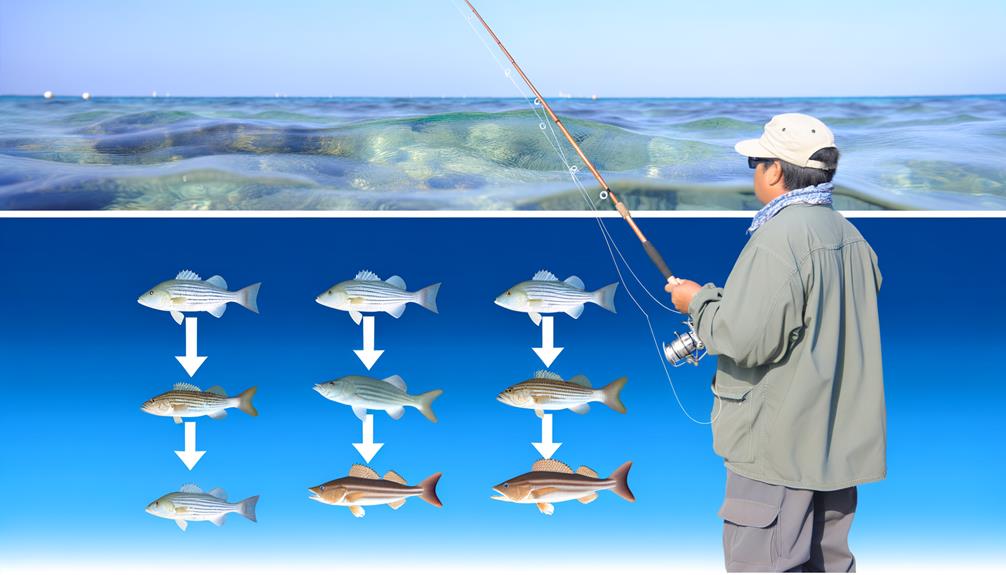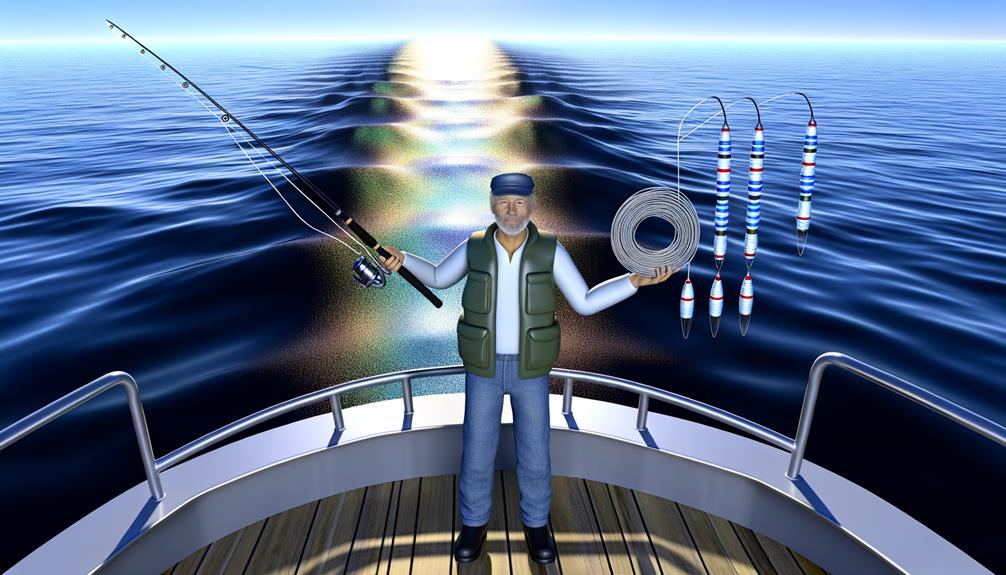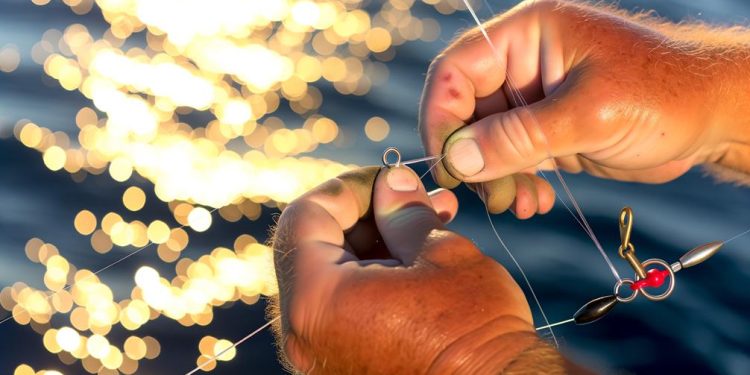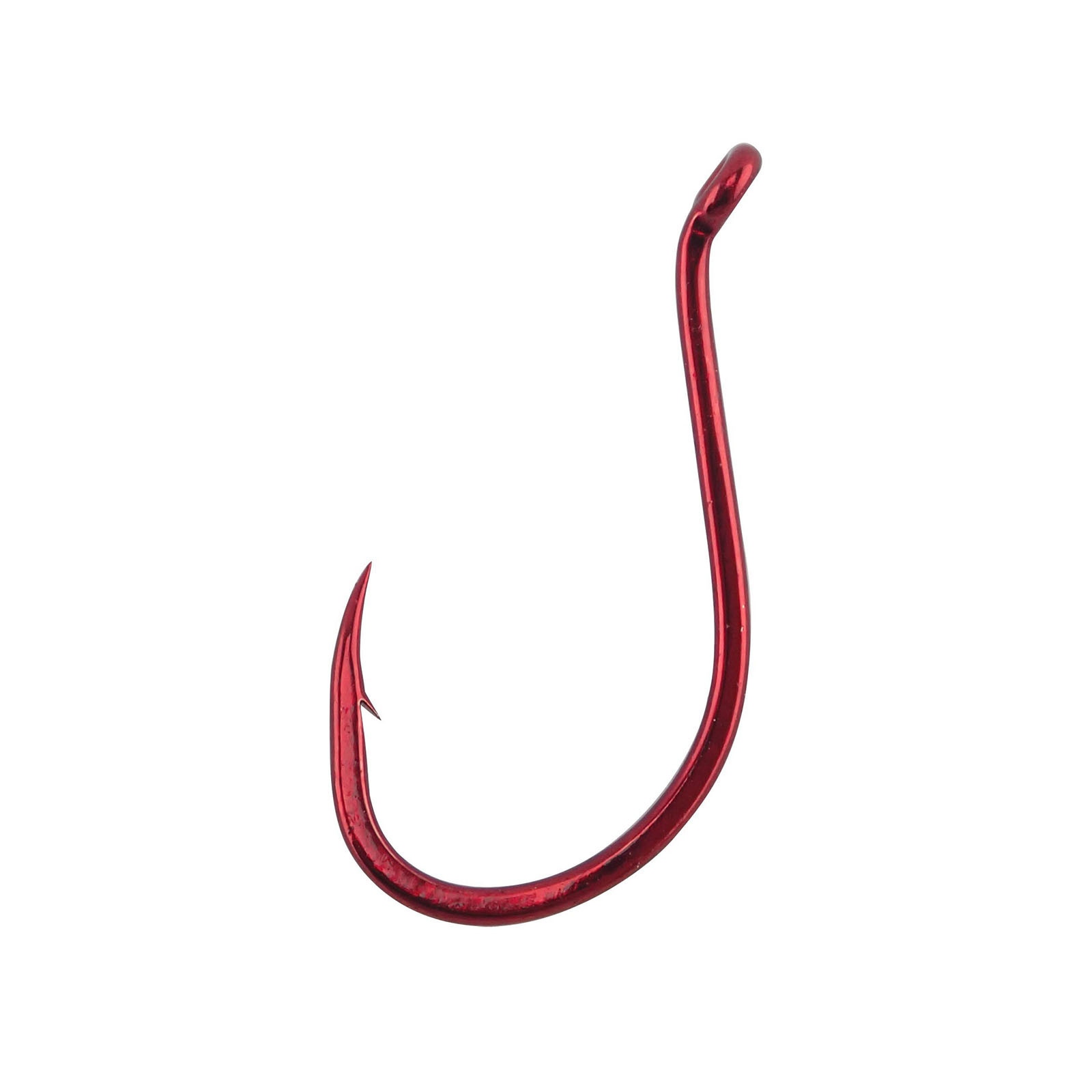Determining the ideal leader line length for saltwater fishing is a nuanced process, influenced by a multitude of factors. This includes the fish species targeted, water clarity, and specific fishing techniques employed.
The commonly suggested leader length of 26 inches, adjustable to about 13 inches, seems to strike a balance between the necessary abrasion resistance and reduced fish detection. Yet, could there be instances where this standard may not be optimal?
This invites us to further investigate the intricate relationship between leader line length and successful saltwater fishing.
Key Takeaways
- The optimal leader line length for saltwater fishing is about two to three times the length of the rod.
- Leader length choice is influenced by factors such as casting ability, water clarity, and fish behavior.
- An optimal leader length can significantly impact fishing success by hiding the braid line and allowing for improved control and flexibility.
- Maximizing catch rate may involve experimenting with different leader lengths, re-tying frayed lines, and understanding fish behavior.
Understanding Leader Lines
In the realm of saltwater fishing, understanding the intricacies of leader lines is paramount, particularly their length, which is typically recommended to be around 2-3 times the length of the fishing rod. The leader line, a vital component of any angler’s arsenal, serves as a bridge connecting the main line to the lure or bait, maintaining a safe distance while increasing the likelihood of a successful catch.
The length of the leader line is a strategic choice, influenced by various factors including fishing scenario, personal preference, and the desired level of abrasion resistance. Longer leader lines, for example, provide enhanced abrasion resistance, essential in saltwater fishing where sharp-toothed species are common. They also facilitate easier handling of fish during landing. Conversely, shorter leader lines offer benefits such as improved casting accuracy and reduced chances of fish detecting the leader.
Ultimately, mastering the balance between these opposing advantages is crucial. It involves a deep understanding of the role of leader lines and the impact their length can have on your saltwater fishing experience. By considering these aspects, you can optimize your approach and enhance your prospects for a successful, enjoyable fishing venture.
Importance of Leader Length
The selection of an optimal leader length in saltwater fishing significantly influences the overall success of the catch. A variety of factors such as casting ability, abrasion resistance, and fish perception should be taken into account while determining the leader length.
In the following sections, we will explore these intricacies in detail to maximize the efficiency and effectiveness of your saltwater fishing experience.
Determining Optimal Leader Length
Balancing control and flexibility in saltwater fishing is often achieved with an optimal leader length of approximately 26 inches. This length allows for easy handling when landing fish and effectively keeps the braid line away from the lure.
However, the optimal leader length can vary based on several factors. For instance, a shorter leader can offer better casting ability while a longer leader provides abrasion resistance and is easier to grab.
| Leader Length | Benefits |
|---|---|
| Shorter (~13 inches) | Better casting ability |
| Optimal (~26 inches) | Balances control and flexibility |
| Longer (>26 inches) | More abrasion-resistant, easier to grab |
Maintaining a consistent leader length, approximately twice the length of the rod, is recommended to ensure smooth casting, retrieval, and knot placement for effective fishing.
Impact on Catch Success
Undeniably, the success of saltwater fishing largely depends on the careful selection and manipulation of leader length. An optimal leader line, about twice the length of your fishing rod, effectively hides the braid line, making it more difficult for fish to detect and thereby increasing your chances to catch fish.
The location of your leader knot can also impact your accuracy and casting distance, further influencing your success. Additionally, adjusting your leader length throughout the day allows for continuous retying without compromising the effectiveness of your line.
Moreover, the choice of leader material significantly affects your outcomes. For example, using a fluorocarbon leader offers low visibility and high abrasion resistance, enhancing your ability to successfully catch wary saltwater fish.
Leader Length Variability Factors
Often, the variability factors of leader length, such as abrasion resistance, ease of handling, and distance from lure, play a crucial role in optimizing performance in saltwater fishing. A lot of people, especially those new to fishing, might not fully grasp the importance of these factors. Hence, it’s essential for effective fishing that these aspects are understood and rights reserved for personal preferences.
| Variability Factors | Long Leader Advantages | Short Leader Advantages |
|---|---|---|
| Abrasion Resistance | Better protection against sharp edges | Less visible to fish |
| Ease of Handling | Easier grip during fish landing | Improved casting ability |
| Distance from Lure | Increased lure movement | Reduced detection by fish |
Choosing an ideal leader length, around 26 inches, provides a balance between control, flexibility, and casting efficiency in saltwater fishing.
Leader Length and Fish Species
Determining the appropriate leader length for saltwater fishing largely depends on the specific species of fish being targeted. Understanding the behavior of your target species and adjusting your leader length accordingly can significantly influence the effectiveness of your fishing approach.
- Fish behavior: The behavior of the fish you’re targeting plays a crucial role in determining the leader length. For instance, shy or easily spooked fish often require longer leaders to ensure the bait appears natural in their environment.
- Target species: The ideal leader length varies between species. Experimenting with different lengths can help identify what works best for your target species.
- Leader effectiveness: The effectiveness of your leader is tied to its length. Too short, and the fish may see your line; too long, and it may become cumbersome to handle.
- Fishing success: The optimal leader length can increase your fishing success. A well-chosen leader length, based on the species behavior and conditions, can significantly improve your catch rates.
Impact of Water Clarity

The clarity of the water significantly influences the length of the leader line used in saltwater fishing, primarily due to the visibility levels it offers to the fish. One of the key water clarity effects on leader line length is the need for a longer leader in situations where the water is crystal clear. Here, the clear water strategies involve adjusting the leader length to about 3-4 feet, as fish in these conditions are more likely to detect shorter, more visible lines.
The increased leader line visibility in clear water can affect fish behavior, making them more cautious and wary. Therefore, a longer leader line can help reduce line visibility, preventing the fish from getting spooked. Moreover, a longer leader line in clear water enhances the presentation of lures or baits, allowing for more natural movements that can entice the fish to bite.
In essence, understanding how water clarity impacts the choice of leader line length can significantly improve your success rate in saltwater fishing, especially in clear water scenarios.
Role of Fishing Techniques
Just as water clarity plays a significant role in selecting the length of the leader line in saltwater fishing, the fishing techniques applied also greatly influence this decision. Understanding the role of fishing techniques in determining leader line length is crucial for adapting to different saltwater fishing conditions.
- Casting Accuracy: Techniques like fly fishing require shorter leader lines. This ensures accurate casting and presentation of the bait or lure, enhancing the chances of success.
- Leader Visibility: When using techniques like bottom fishing or trolling, longer leader lines are beneficial. They prevent the fish from seeing the main line, thus increasing the catch rate.
- Lure Presentation: The leader length is critical in effective lure presentation. A long leader might compromise the action of the lure, while a short one may scare away the fish.
- Fish Behavior: Recognizing and adapting to fish behavior is pivotal in leader line choice. For skittish fish, a longer, less visible leader may prove successful, while aggressive species may not require such caution.
Expert Recommendations

In the realm of saltwater fishing, expert opinions are invaluable for determining the optimal leader line length. The ideal length, influenced by various factors, will balance advantages such as abrasion resistance and casting ability.
This discussion will elucidate the recommended leader line lengths, the variables that influence these recommendations, and the reasoning behind variations in length.
Ideal Leader Line Length
For optimal performance in saltwater fishing, experts recommend starting with a leader line around 26 inches in length. This measurement is not just arbitrary; it is based on careful consideration of handling techniques and leader effectiveness.
- Leader Flexibility and Catch Rate: A leader line of this length allows for ample flexibility, directly influencing your catch rate positively.
- Abrasion Resistance: Longer leader lines provide better abrasion resistance, which is crucial in saltwater environments.
- Handling Techniques: The recommended length also eases handling, especially when landing a fish.
- Casting Accuracy: Lastly, a 26-inch leader line ensures improved casting accuracy, reducing the chance of the fish feeling the leader.
Factors Influencing Length Choice
Several factors come into play when determining the optimal leader line length for saltwater fishing, as suggested by industry experts. Leader line flexibility is essential, providing abrasion resistance and ease of handling during fish landing. However, overly long leaders can limit casting ability, so a balance must be achieved.
Fish behavior also impacts length choice, as some species are more likely to detect and shy away from a visible line. Thus, line visibility is a key consideration. Shorter leaders can reduce the chance of fish feeling the leader, enhancing the angler’s stealth approach.
Therefore, in addition to the angler’s skill set and target species, leader line flexibility, fish behavior, and line visibility are critical in determining the proper leader line length.
Leader Line Length Variations
Navigating through expert recommendations, it becomes clear that a successful saltwater fishing experience often begins with utilizing a leader line of approximately 26 inches in length. This length ensures optimal control while preserving leader line flexibility, key for an effective catch.
Experts recommend the following leader line length variations and their benefits:
- Beginning with a leader line of approximately 26 inches ensures sufficient flexibility and control.
- Trimming frayed parts until the leader line reaches about 13 inches can optimize performance.
- Re-tying a new leader line of 26 inches again is advised for continuous fishing success.
- Ensuring the knot sits on top of the spool line aids in smooth casting and retrieval.
These leader line trimming techniques can significantly enhance your fishing performance, making every saltwater expedition a success.
Common Mistakes to Avoid

When it comes to saltwater fishing, it’s imperative to avoid certain common errors associated with the use of leader lines, such as underestimating or overestimating the necessary length, in order to maintain optimal lure performance and casting accuracy. Such common mistakes can hinder effective connections and compromise the overall fishing experience.
Proper adjustments based on target species and fishing conditions are crucial for effective use of leader lines. Neglecting to make these necessary adjustments is a common pitfall. Similarly, using a leader line that is too thick can negatively affect lure action and potentially deter your target fish.
Below is a summary of common mistakes and their potential impacts:
| Common Mistakes | Potential Impacts |
|---|---|
| – | – |
| Using a line that is too short | Decreases effectiveness of connection |
| Using a line that is excessively long | Hinders casting accuracy |
| Neglecting necessary adjustments | Compromises optimal performance |
| Using a line that is overly long | Increases risk of tangles and reduces sensitivity |
| Using a line that is too thick | Impacts lure action and scares off fish |
Maximizing Catch Rate
In the pursuit of maximizing catch rates in saltwater fishing, a tactful approach to leader line length can significantly enhance the chances of a successful catch. The optimal leader length often lies around two to three times the length of the fishing rod, providing appropriate control and flexibility. This setting maintains a consistent leader length, crucial for better casting accuracy and minimizing the risk of fish detecting the leader.
Achieve an optimal catch rate by considering the following four factors:
- Leader line flexibility: Longer lines provide increased flexibility, essential when dealing with larger or more powerful species.
- Leader line visibility: A longer leader line helps prevent fish from detecting the main braid line, increasing your chances of a successful catch.
- Leader line control: Control is enhanced with a leader line that is approximately 2-3 times the length of the fishing rod.
- Experimentation: Varying leader lengths can help determine the most effective setup per the varying conditions of saltwater fishing.
Understanding these factors and applying them thoughtfully will ensure you belong among the most successful anglers.
Frequently Asked Questions
How Long Should Your Leader Line Be?
The ideal leader line length depends on factors such as line durability, leader materials, and knot strength. Generally, starting with a length around 26 inches offers a balance between performance and adaptability in various conditions.
Do You Need a Leader for Saltwater Fishing?
Yes, a leader is necessary for saltwater fishing due to its decreased visibility and abrasion resistance. Its material differences can impact success with varying fish species, making it an essential component in a saltwater angler’s toolkit.
How Long Should a Leader Be for Beach Fishing?
The length of a leader for beach fishing, influenced by tide conditions, bait selection, and casting techniques, typically ranges between 2 to 4 feet. Adjustments are made based on water clarity and the behavior of the target fish.
Does Leader Length Matter?
Yes, leader length is crucial in saltwater fishing. It influences line preference and technique variations, offering balance between visibility and strength. It’s an important decision reflecting your understanding of the marine environment and target species.
Conclusion
In conclusion, the length of a leader line for saltwater fishing significantly influences the success rate of your catch. Balancing factors such as abrasion resistance, handling ease, and reduced fish detection can optimize your fishing experience.
A starting point of a 26-inch leader is advisable, maintaining it at about 13 inches for optimal performance. Consideration of fish species, water clarity, and fishing techniques can further enhance your results, ensuring a rewarding saltwater fishing endeavor.





